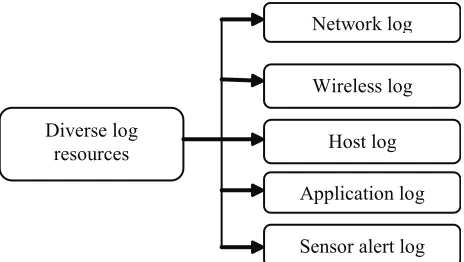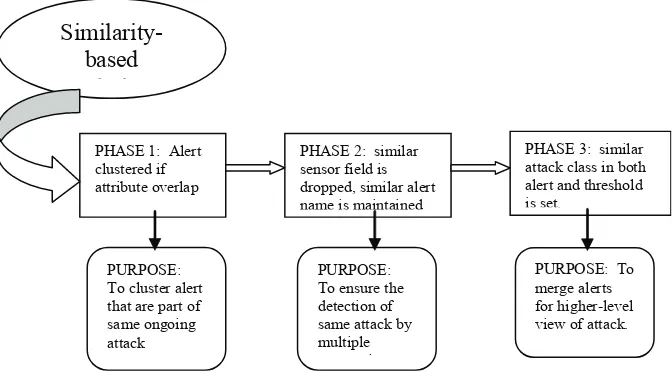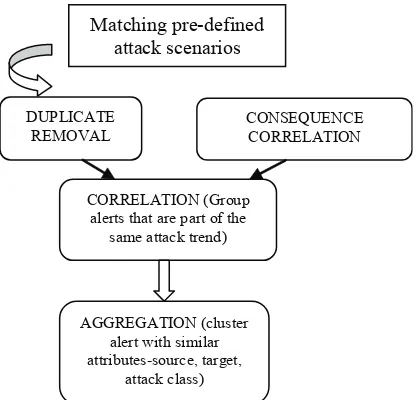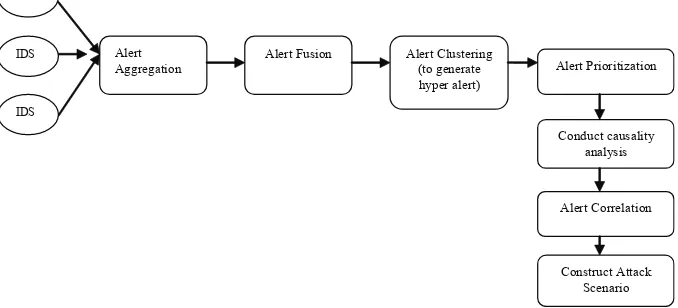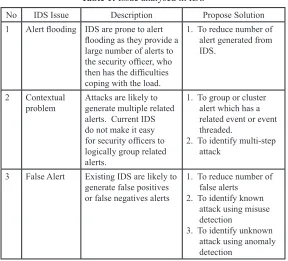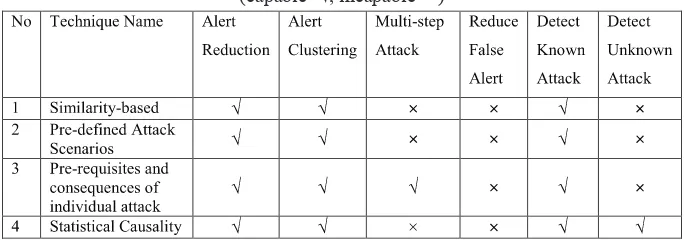Robiah, Y. 2, Rahayu, S.S. 2, Shahrin, S. 1, Faizal, M.A. 2 1Professor Dr. 2Fakulti Teknologi Maklumat & Komunikasi
Universiti Teknikal Malaysia Melaka Locked Bag 1200, Ayer Keroh Hang Tuah Jaya, 75450, Melaka, Malaysia Corresponding author’s e-mail: [email protected],
ABSTRACT: Alert correlation is a process that analyses the alerts produced by one or more diverse devices and provides a more succinct and high-level view of occurring or attempted intrusions. The objective of this study is to analyse the current alert correlation technique and identify the signiicant criteria in each technique that can improve the Intrusion Detection System (IDS) problem such as prone to alert looding, contextual problem, false alert and scalability. The existing alert correlation techniques had been reviewed and analysed. From the analysis, six capability criteria have been identiied to improve the current alert correlation techniques which are capability to do alert reduction, alert clustering, identify multi-step attack, reduce false alert, detect known attack and detect unknown attack and technique’s combination is proposed.
Keyword: IDS, Alert correlation, diverse devices log, capability criteria
1.0
Introduction
Computer security offers three types of security mechanism to protect a system which are authentication, authorisation and auditing for securing the systems against attack. In order to provide extra layers of defence in case of these mechanisms are laws, IDS have been proposed. Intrusion detection technology has gained increasing acceptance in enterprise networks, with both commercially supported and open source components widely deployed (Anderson, Fong, & Valdes, 2002). However, it has few weaknesses such as prone to alert looding, contextual problem due to attacks are likely to generate multiple related alert, false alert and scalability (Debar & Wespi, 2001) and correlation is proposed to overcome these weaknesses.
complete coverage of the attack space. However, the potential added leverage from devices diversity is not clear that require the security administrator’s decision on which reports pertains to the same or to different incidents. This issue has motivated the researcher to do research on correlation of alert produce by intrusion detection sensor and diverse log resources.
Diverse log
resources Host log
Network log
Application log Wireless log
Sensor alert log
Figure 1: Domain perspective of diverse log resources
2.0
Intrusion Alert Correlation
Alert can be produced from various types of sources and it may cause multiple stages of attack. Alert correlation is multi-step processes that receives alerts from one or more IDS as input and produce a high-level description of the malicious activity on the network. According to (Hattala, Sars, Addams, & Virtanen, 2004), to achieve good recognition, the data needs to be collected from various sources (for example irewall, web server logs, IDS of multiple manufacturers and so on). Correlation of alerts produced by diverse log resources can provide a number of potential advantages and the most obvious beneit is the reduction in the number of alerts that a security oficer must address.
techniques may reinforce each other and therefore enhance the conidence of the detection.
3.0
Related Works on Current Alert Correlation Technique
There are four techniques exist in correlating alerts which are Similarity-based, Pre-deined attack scenarios and Pre-requisites and consequences of individual attack and Statistical causal analysis (refer to Figure 2).
SIMILARITY-BASED
PRE-DEFINED ATTACK SCENARIOS
PRE-REQUISITES AND CONSEQUENCES OF INDIVIDUAL ATTACK
STATISTICAL CAUSAL ANALYSIS ALERT
CORRELATION TECHNIQUE
Figure 2: Classiication of Alert Correlation Technique
3.1 Similarity-Based
PHASE 1: Alert
Figure 3: Similarity-based intrusion alert correlation process by Valdes & Skinner.
The metric for this phase demand that sensor ield, attack class, attack name, source and target in both alerts are similar. In second phase, different levels of similarity are expected for different attributes in different situation whereby similar sensor ield is dropped and similar alert name is maintained. This phase is to ensure that detection of the same attack by multiple sensors should be fused. Then in third phase, it requires similar attack class in both alert. Certain threshold is adjust for example for synthetic threads, sensor id and IP is set high and for multistep attack detection, threshold for attack class is set to low. This phase will merge alerts representing different attack steps to provide a higher-level view of the security state of the system.
3.2 Pre-Deined Attack Scenarios
This technique utilizes the fact that intrusions often require several actions to take place in order to succeed. Every attack scenario has corresponding steps required for the successfulness of the attack. Low- level alerts from IDS are compared against the pre-deined attack scenario before the alerts can be correlated. It is restricted to known attack and misuse detection only and speciied by human users or learned through training datasets. The example of implementation is ASL (Attack Speciication Language).
of intrusion detection alerts produced by various sensor as in Figure 4. In correlation phase, there are two types of correlation which are duplicate removal and consequence correlation.
Matching pre-defined attack scenarios
CORRELATION (Group alerts that are part of the
same attack trend)
AGGREGATION (cluster alert with similar attributes-source, target,
attack class) DUPLICATE
REMOVAL
CONSEQUENCE CORRELATION
Figure 4: Pre-deined attack scenarios intrusion alert correlation process by Debar & Wespi.
Duplicates are instances of the same attack as detected using rules read from a speciied coniguration ile by two different sensor. Consequences are rules that specify one event should be followed by another type of event. It will link together alerts that are sequential in nature. Once alerts has correlated, aggregation phase will cluster alerts with similar attributes (source, target and attack class). It identiies the source of the attack, the target of the attack and popular attack class. It will group alerts based on certain criteria to aggregate severity level, reveal trends and clarify attacker’s intentions. This phase consists of large number of false positive, however there is no speciic technique can eliminate this problem. Major weakness of this method are, it requires that human users specify attack scenarios and it is limited to detection of known attacks.
3.3 Pre-Requisites and Consequences of individual attacks
formula using AND and OR connectives. This technique is not restricted to known attack scenarios and its uncover the causal relationship between alerts. Most of the approaches using this method are focused on the modeling and detection of multistep attacks to provide a high-level of the attack associated with a security compromise.
Figure 5: Pre-requisite and Consequences of individual attack intrusion alert correlation process by Cuppens & Miege.
By using these technique as depicted in Figure 5, (Cuppens & Miege, 2002) has include ive functions including alert base management, alert clustering, alert merging, alert correlation and intention recognition function. In alert base management function, it receives alerts generated by IDS and stores them for further analysis by cooperation module. This alert will be normalized to IDMEF format and store in the relational database. Alert cluster and alert merging function can access the database and will use the similarity function to cluster and merge the alert. Alert correlation function will further analyzes the cluster alerts provided by alert merging function using explicit correlation rules with pre-deined and consequence statement. This approach attempt to generate correlation rules automatically which can introduce correlated alerts that are similar by chance and this could increase the noise in the alert stream.
3.4 Statistical Causal Analysis
This technique by (Qin & Le, 2003) as shown in Figure 6, implements anomaly detection and use Granger Causality Test (time series analysis method) to correlate events which emphasis on attack scenario analysis. In order to reduce the volume of raw alerts, it will combine low-level alert based on alert attributes. It uses clustering technique to process low-level alert-data into high-level aggregated alerts. Prioritization alerts is used based on relevance of attacks and impacts on the mission goal. It will then conduct causality analysis to correlate alerts and constructs attack scenario. It is pure statistical causality analysis and does not need pre-deined knowledge about attack scenarios. Hence, new attack scenarios can be identiied.
Alert Aggregation
Alert Fusion Alert Clustering (to generate hyper alert)
Alert Prioritization
Alert Correlation
IDS
Conduct causality analysis
Construct Attack Scenario
IDS
IDS
Figure 6: Statistical Causality Analysis alert correlation process by Qin & Le
This technique declares that every multi-step attack will generate alert that have statistical similarities in their attributes, and this attack steps have causal relationship. (Qin & Le, 2003) run the statistical correlation engine ofline with training datasets to compute and store correlations so that it can be used for pattern matching at run-time. This technique is not a feasible solution for the complete correlation process. However it can be utilized as a part of a larger system to pre-process alerts or to provide meta-alert signatures.
4.0
Review and Analysis of Alert Correlation Technique
4.1 Alert Correlation Techniques Comparison
criteria as stated in section 4.2. In similarity-based, the advantage of this technique is that it has the capability to reduce large number of redundant alert generated by multiple sensors. However, this technique is not able to detect false alert if others sensors cannot detect the same attack simultaneously. Due to this disadvantageous this technique is not capable to detect multi-step attack. Moreover, it can only detect misuse detection and not anomaly-detection. In Pre-deined attack scenarios, it has similar advantage to similarity-based technique. In addition, it can cluster multiple related alerts and detect precise attack as stated in the rules. However, according to (Valeur, 2006) it could generate large number of false positive alarm and it requires that users specify attack scenarios manually. Furthermore, it is limited to detection of known attacks or misuse detection and multi-step attack alert is disregarded.
For Pre-requisites and consequences of individual attack, the good news is that multi-step attack can be detected to provide a high-level view of the attack associated with a security compromise and generate useful graph to determine the attacker’s objective (Ning, Cui, & Reeves, Analyzing Intensive Intrusion Alerts via Correlation, 2002). Nevertheless, according to (Cuppens & Miege, 2002), automatic generation correlation rules can generate large false alarm. Statistical Causality Analysis has the advantage of not needed pre-deined knowledge about attack scenarios as this technique use anomaly-based for detection so that new attack scenarios can be identiied. This technique is ideal to be used as pre-process alerts or meta-alert signatures. Even so, according to (Hattala, Sars, Addams, & Virtanen, 2004), this technique is not feasible for complete correlation process
4.2 Proposed Criteria for Alert Correlation Technique
Table 1: Issue analysed in IDS
No IDS Issue Description Propose Solution
1 Alert looding IDS are prone to alert
looding as they provide a
large number of alerts to
the security oficer, who
2. To identify multi-step attack
3 False Alert Existing IDS are likely to generate false positives
3. To identify unknown attack using anomaly detection
Based on the IDS current issues, most of the current alert correlation techniques were developed in order to improve this problem. Therefore the proposed criterion that shall be analysed is according to the capability criteria as listed below:
1. Capability to do alert reduction 2. Capability to do alert clustering 3. Capability to identify multi-step attack. 4. Capability to reduce false alert.
5. Capability to detect known attack 6. Capability to detect unknown attack
is becoming more sophisticated and it shall involve one to many, many to one and many to many attacks. For fourth criteria, most of the IDS have the tendency to produce false alarm. This false alarm reduction criterion is important as it closely related to alert looding issue. The ifth and sixth criterion, the capability to detect both known and unknown attack is required to ensure that the alert generated will overcome the issue of alert looding and false alert. Table 2, is the summary of analysis from each alert correlation techniques match with the proposed capability criteria.
Table 2: Alert correlation technique versus proposed capability criteria (capable=√, incapable=×)
Based on the analysis, all of the techniques have the same capability to reduce and cluster the alert, and detect known attack except for pre-requisite and consequences of individual attack and statistical causality technique. The additional capability of pre-requisite and consequences of individual attack is to identify multi-step attack whereas the unknown attack can be detected using statistical causality technique. None of the technique is best for detecting malware and the researcher proposed that a combination of Pre-requisites and consequences of individual attack with Statistical causality will at least overcome the problem in detecting unknown attack and multi-step attack but still the false alert problem are still exist. This has given an implication that there is a room for improvement for each of the technique in detecting known and unknown attack, and multi-step attack as these capability criteria shall overcome large number of false alert problem.
5.0
Conclusion and Future Works
reduction, capability to do alert clustering, capability to identify multi-step attack, capability to reduce false alert, capability to detect known attack and capability to detect unknown attack. According to the capability criteria, none of the correlation techniques can stand on its own in detecting the malware intrusion. Further improvement should be done on the process of detecting the known and unknown attack, and multi-step attack as these capability criteria shall overcome large number of false alert problem. Therefore further research on intrusion alert correlation technique with these capabilities to detect unknown attack using combination of anomaly and misuse detection approach is required.
References
Anderson, D., Fong, M., and Valdes, A., (2002), Heterogeneous Sensor Correlation: A Case Study of Live Trafic Analysis. Proceeding 3rd Annual IEEE Information
Assurance Workshop.
Cuppens, F., and Miege, A., (2002), Alert Correlation in a Cooperative Intrusion Detection Framework. Proceedings of IEEE Symposium Security and Privacy.
Debar, H., and Wespi, A., (2001), Aggregation and Correlation of Intrusion Detection Alerts. Proceedings of the International Symposium on Recent Advances in Intrusion Detection, (pp. 85-103). Davis, CA.
Valeur, F., (2006), Real-time Intrusion Detection Alert Correlation. PhD Thesis, University of California Santa Barbara, USA.
Gorton, D., (2003), Extending Intrusion Detection with Alert Correlation and Intrusion
Tolerance. MPhil Thesis , Chalmers University of Technology, Department
of Computer Engineering, Goteborg, Sweden.
Hattala, A., Sars, C., Addams, R., and Virtanen, T., (2004), Event Data Exchange and Intrusion Alert Correlation in Heterogeneous Networks. 8th Colloqium for
Information Systems Security Education. West Point, New York.
Ning, P., Cui, Y., and Reeves, D., (2002)a, Analyzing Intensive Intrusion Alerts via Correlation. Proceedings of the International Symposium on the Recent Advances in Intrusion Detection, (pp. 74-94). Zurich, Switzerland.
Ning, P., Cui, Y., & Reeves, D., (2002)b, Constructing Attack Scenarios through Correlation of Intrusion Alerts. Proceedings of the ACM Conference on
Computer and Communications Security, (pp. 245-254). Washington D.C.
Valdes, A., & Skinner, K., (2001), Probablistic Alert Correlation. Proceedings of the
Recent Advances in Intrusion Detection (RAID). Davis, CA.
